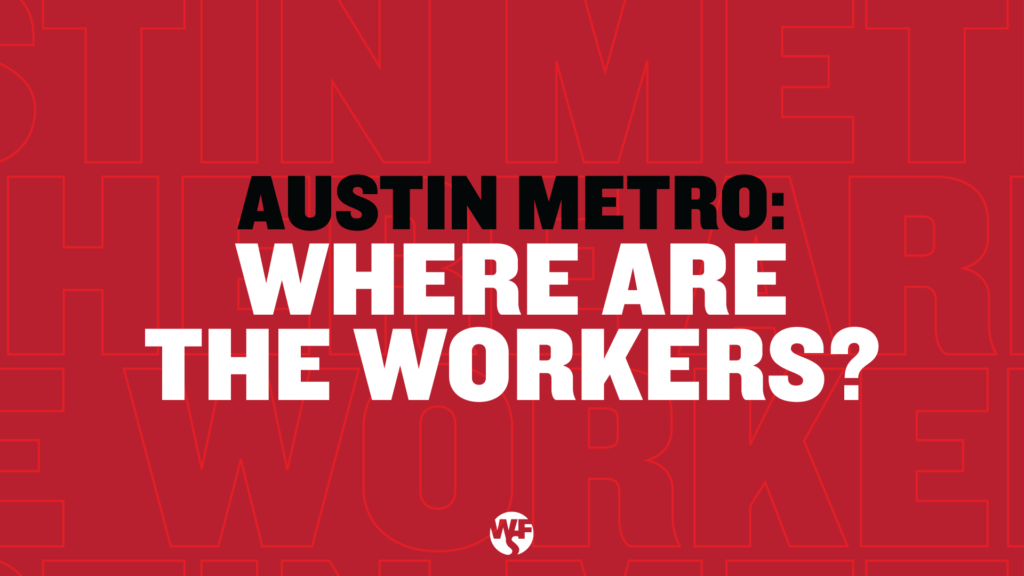🤓 I have data for you to address the question on everyone’s minds: “Are people working?
👋 Not a goodbye, but see you later: I’m transitioning to a new format and release date for these letters, starting next month.
- So you still get a rundown of the latest workforce news and happenings, you’ll receive our revamped Working in Austin newsletter, released at the end of each month.
- I’ll still send you CEO Letters — just once in the middle of each month. But the content will be a bit more personal…
☝️ 1 last thing: I look forward to joining Travis County Commissioner Travillion andManor ISD for a community engagement session Wednesday, April 6.
- This session is the first in a series to launch and discuss Austin’s new Hire Local Plan with community leaders. We’re looking to hold one in each of our local districts and precincts in partnership with our elected, education, and business leaders. More to come!
Let’s dive in…
Were you forwarded this email? Sign up to receive my weekly updates here.

1. 📈 WFS Report: Are people working?
The size of Austin metro’s labor force and the total number of residents employed have exceeded post-pandemic levels, a new Workforce Solutions Capital Area (WFS) report shows.
The big picture: Statistically speaking, most Austinites are working, and the region is attractive for in-bound talent.
The challenge — which is a positive economic sign — is that job creation is also increasing, and workers have options.
- Talent shortages are still acute and felt by every industry in Austin and across the country.
Here are three key findings from the report…
1 / The Austin metro labor force (or sum of employed and unemployed persons) stood at 1.32 million people as of December 2021. Comparatively, the labor force stood at 1.26 million people in February 2020, according to seasonally adjusted data from JobsEQ.
- Further, as of December 2021, there are 1.28 million people in the labor force who are employed and working, compared to 1.22 million in February 2020.
2 / Austin metro’s labor force participation rate is 71.20% as of December 2021,which stands above the 2019 rate of 70.37%, according to Emsi data.
- The participation rate is an important labor market measure because it represents the relative amount of labor resources available for the production of goods and services.
3 / Population is growing in our metro. An important factor is domestic migration, or people who move to the area from other states. Domestic migration indicates how attractive a region is to prospective talent.
- In 2020, the Austin metro experienced an above-average domestic migration rate at 21.3%, or 48,873 people, compared to previous years.
- Austin started to see a significant bump in migration rates beginning in 2019 (18.6%) compared to 2018 (13.7%).
Bottom line: Our booming economy means more opportunities, especially for people with skills.
- To address the short supply of talent for available jobs, WFS operates with a “no worker left behind” mentality of finding and engaging workers, such as our unemployed and underemployed neighbors.
- WFS is invested in growing our workforce. We’re connecting local people to the skills needed for higher-paying careers here in Austin-Travis County.

2. Austin unemployment rate steady at 3.3% in February 2022
The new jobs report released Friday says the Austin metro unemployment rate stayed steady in February, remaining just above pre-pandemic levels.
- Austin metro unemployment held at 3.3% from January 2022 to February 2022, representing 44,912 unemployed residents, according to the Texas Workforce Commission (TWC).
- Texas unemployment dropped to 4.7%, remaining above the national unemployment rate (4.1%).
- Capital Area/Travis County unemployment also stayed steady at 3.3% from January to February, representing 25,942 jobless residents.
Of note: The unemployment data released today are not adjusted for seasonal patterns.
Austin metro in February, by the numbers:
- 11,700 jobs were gained from January to February.
- Industries that experienced significant regional job growth from January to February include Leisure & Hospitality (4,600), Education & Health Services (2,300), and Trade, Transportation & Utilities (1,700).
- Other industries that experienced monthly job growth include Manufacturing (1,400), Professional & Business Services (1,400), and Government (1,100).
- The Austin metro’s annual growth rate of 9.1% represents the collective gain of 101,700 jobs since February 2021.
- 27,924 new job ads were posted in the Austin metro in February 2022, according to Burning Glass Labor Insight. That’s 7,966 more than in February 2021.
- See more February job postings data on our website.
My takeaway: Austin is moving in the right direction. But with more jobs than workers, our mission to grow Austin’s workforce and talent is more critical than ever.

